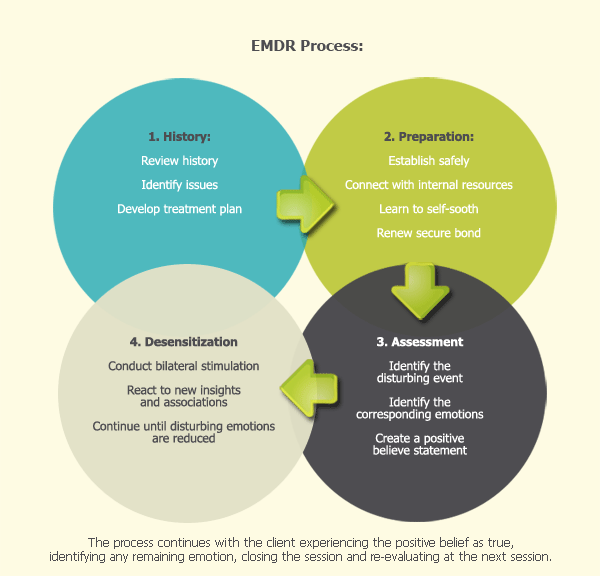According to the EMDR International Association, Eye Movement Desensitization and Reprocessing (EMDR) therapy is an integrative psychotherapy approach that has been extensively researched and proven effective for the treatment of trauma. EMDR is a set of standardized protocols that incorporates elements from many different treatment approaches. To date, EMDR therapy has helped millions of people of all ages relieve many types of psychological stress.1 EMDR is an evidence-based psychotherapy for Posttraumatic Stress Disorder (PTSD). In addition, successful outcomes are well-documented in the literature for EMDR treatment of other psychiatric disorders, mental health problems, and somatic symptoms. The model on which EMDR is based, Adaptive Information Processing (AIP), posits that much of psychopathology is due to the maladaptive encoding of and/or incomplete processing of traumatic or disturbing adverse life experiences. This impairs the client’s ability to integrate these experiences in an adaptive manner. The eight-phase, three-pronged process of EMDR facilitates the resumption of normal information processing and integration. This treatment approach, which targets past experience, current triggers, and future potential challenges, results in the alleviation of presenting symptoms, a decrease or elimination of distress from the disturbing memory, improved view of the self, relief from bodily disturbance, and resolution of present and future anticipated triggers.2
EMDR has a broad base of published case reports and controlled research that supports it as an empirically validated treatment of trauma and other adverse life experiences. The Department of Defense/Department of Veterans Affairs Practice Guidelines have placed EMDR in the highest category, recommended for all trauma populations at all times. In addition, the International Society for Traumatic Stress Studies current treatment guidelines have designated EMDR as an effective treatment for PTSD (Foa, Keane, Friedman, & Cohen, 2009) as have the Departments of Health of both Northern Ireland and Israel, which have indicated EMDR to be one of only two or three treatments of choice for trauma victims. The American Psychiatric Association Practice Guideline (2004) has stated that SSRI’s, CBT, and EMDR are recommended as first-line treatments of trauma. Most recently, the World Health Organization (2013) has stated that trauma-focused CBT and EMDR are the only psychotherapies recommended for children, adolescents, and adults with PTSD. Like CBT with a trauma focus, EMDR aims to reduce subjective distress and strengthen adaptive cognitions related to the traumatic event. Unlike CBT with a trauma focus, EMDR does not involve detailed descriptions of the event, direct challenging of beliefs, extended exposure, or homework.3

Sources
Generate HTML color codes with the color picker that converts to hex and reg code and generates the most common code snippets to use in your document.
